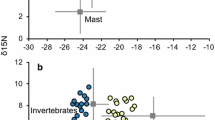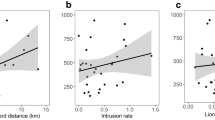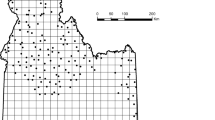Abstract
Anthropogenic disturbances have altered species’ distributions potentially impacting interspecific interactions. Interference competition is when one species denies a competing species access to a resource. One mechanism of interference competition is aggression, which can result in altered space-use of a subordinate species due to the threat of harm, otherwise known as a ‘landscape of fear’. Alternatively, subordinates might outcompete dominant species in resource-poor environments via a superior ability to extract resources. Our goal was to evaluate spatial predictions of the ‘landscape of fear’ hypothesis for a carnivore guild in Newfoundland, Canada, where coyotes recently immigrated. Native Newfoundland carnivores include red foxes, Canada lynx, and black bears. We predicted foxes and lynx would avoid coyotes because of their larger size and similar dietary niches. We used scat-detecting dogs and genetic techniques to locate and identify predator scats. We then built resource selection functions and tested for avoidance by incorporating predicted values of selection for the alternative species into the best supported models of each species. We found multiple negative relationships, but notably did not find avoidance by foxes of areas selected by coyotes. While we did find that lynx avoided coyotes, we also found a reciprocal relationship. The observed patterns suggest spatial partitioning and not coyote avoidance, although avoidance could still be occurring at different spatial or temporal scales. Furthermore, Newfoundland’s harsh climate and poor soils may swing the pendulum of interspecific interactions from interference competition to exploitative competition, where subordinates outcompete dominant competitors through a superior ability to extract resources.






Similar content being viewed by others
Notes
Any use of trade, firm, or product names is for descriptive purposes only and does not imply endorsement by the U.S. Government.
References
Bastille-Rousseau G, Schaefer JA, Lewis KP, Mumma MA, Ellington EH, Rayl ND, Mahoney SP, Pouliot D, Murray DL (2016) Phase-dependent climate-predator interactions explain three decades of variation in neonatal caribou survival. J Anim Ecol 85:445–456
Bates D, Maechler M, Bolker B, Walker S (2015) Fitting linear mixed-effects models using lme4. J Stat Softw 67:1–48
Berger J (2010) Fear-mediated food webs. In: Terborgh J, Estes JA (eds) Trophic cascades: predators, prey, and the changing dynamics of nature. Island Press, Washington DC, pp 241–254
Boisjoly D, Ouellet JP, Courtois R (2010) Coyote habitat selection and management implications for the Gaspésie caribou. J Wildl Manag 74:3–11
Boyce MS, Vernier PR, Nielson SE, Schmiegelow FKA (2002) Evaluating resource selection functions. Ecol Model 157:281–300
Brown SM, Harrisson KA, Clarke RH, Bennett AF, Sunnucks P (2013) Limited population structure, genetic drift and bottlenecks characterize an endangered bird species in a dynamic, fire-prone ecosystem. PLoS One 8:e59732
Burnham KP, Anderson DR (2002) Model selection and multi-model inference: a practical information-theoretic approach, 2nd edn. Springer-Verlag, New York
Case TJ, Gilpin ME (1974) Interference competition and niche theory. Proc Natl Acad Sci 71:3073–3077
COSEWIC (2002) COSEWIC assessment and update status report on the woodland caribou, Rangifer tarandus caribou, in Canada. Committee on the Status of Endangered Wildlife in Canada (COSEWIC), Environment Canada, Gatineau, Quebec
Creel S, Creel NM (1996) Limitations of African wild dogs by competition with larger carnivores. Conserv Biol 10:526–538
Crete M, Desrosiers A (1995) Range expansion of coyotes, Canis latrans, threatens remnant herd of caribou, Rangifer tarandus, in southeastern Quebec. Canadian Field-Naturalist 109:207–235
Dawe KL, Bayne EM, Boutin S (2014) Influence of climate and human land use on the distribution of white-tailed deer (Odocoileus virginianus) in the western boreal forest. Can J Zool 92:353–363
Department of Environment and Conservation (2012) Genetic retesting of DNA confirms second wolf on Island of Newfoundland. http://www.releases.gov.nl.ca/releases/2012/env/0823n04.htm. Accessed 6 Oct 2017
Durant SM (2000) Living with the enemy: avoidance of hyenas and lions by cheetahs in the Serengeti. Behav Ecol 11:624–632
Ermala A (2003) A survey of large predators in Finland during the 19th–20th centuries. Acta Zool Litu 13:15–20
Fedriani JM, Fuller TK, Sauvajot RM, York EC (2000) Competition and intraguild predation among three sympatric carnivores. Oecologia 125:258–270
Fordham DA, Georges A, Brook BW (2008) Indigenous harvest, exotic pig predation and local persistence of a long-lived vertebrate; managing a tropical freshwater turtle for sustainability and conservation. J Appl Ecol 45:52–62
Frantzen MA, Silk JB, Ferguson JWH, Wayne RK, Kohn MH (1998) Empirical evaluation of preservation methods for fecal DNA. Mol Ecol 7:1423–1428
Fraser EJ, Lambin X, Travis JMJ, Harrington LA, Palmer SCF, Bocedi G, MacDonald DW (2015) Range expansion of an invasive species through a heterogenous landscape—the case of American mink in Scotland. Divers Distrib 21:888–900
Gorman ML, Trowbridge BJ (1989) The role of odor in the social lives of carnivores. In: Gittleman JL (ed) Carnivore, behavior, ecology and evolution. Cornell University Press, Ithaca, pp 57–139
Grassel SM, Rachlow JL, Williams CJ (2015) Spatial interactions between sympatric carnivores: asymmetric avoidance of an intraguild predator. Ecol Evol 5:2762–2773
Grohmann CH, Smith MJ, Ricconini C (2011) Multiscale analysis of topographic surface roughness in the Midland Valley, Scotland. IEEE Trans Geosci Remote Sens 49:2000–2013
Gutzwiller KJ (1990) Minimizing dog-induced biases in game bird research. Wildl Soc Bull 18:351–356
Harrison DJ (1986) Coyote in the northeast—their history, origin, and ecology. Appalachia 182:30–39
Harrison DJ, Bissonette JA, Sherburne JA (1989) Spatial relationships between coyotes and red foxes in eastern Maine. J Wildl Manag 53:181–189
Hayward MW, Slotow R (2009) Temporal partitioning of activity in African carnivores: tests of multiple hypotheses. S Afr J Wildl Res 39:109–125
Holt RD, Polis GA (1997) Theoretical framework for intraguild predation. Am Nat 149:745–764
Integrated Informatics Inc. (2014) Sustainable Development & Strategic Science Branch land cover classification. Sustainable Development and Strategic Science, Government of Newfoundland and Labrador, St. John’s, NL
Ivan JS, Shenk TM (2016) Winter diet and hunting success of Canada lynx in Colorado. J Wildl Manag. doi:10.1002/jwmg.21101
Johnson CJ, Seip DR, Boyce MS (2004) A quantitative approach to conservation planning: using resource selection functions to map the distribution of mountain caribou at multiple spatial scales. J Appl Ecol 41:238–251
Jung TS, Stotyn SA, Czetwertynski SM (2015) Dietary overlap and potential competition in a dynamic ungulate community in northwestern Canada. J Wildl Manag 79:1277–1285
Kamler JF, Stenkewitz U, Macdonald DW (2013) Lethal and sublethal effects of black-backed jackals on cape foxes and bat-eared foxes. J Mammal 94:295–306
Kuhn M, Wing J, Weston S, Williams A, Keefer C, Engelhardt A, Cooper T (2013) caret: classification and regression training. R Package Version 5:15–61
Latham AD, Latham MC, Knopff KH, Hebblewhite M, Boutin S (2013) Wolves, white-tailed deer, and beaver: implications of seasonal prey switching for woodland caribou declines. Ecography 36:1276–1290
Laundré JW, Hernández L, Altendorf KB (2001) Wolves, elk, and bison: reestablishing the ‘landscape of fear’ in Yellowstone National Park, U.S.A. Can J Zool 79:1401–1409
Levi T, Kilpatrick AM, Mangel M, Wilmers CC (2012) Deer, predators, and the emergence of Lyme disease. Proc Natl Acad Sci 109:10942–10947
Lewis KP, Mahoney SP (2014) Caribou survival, fate, and cause of mortality in Newfoundland: a summary and analysis of the patterns and causes of caribou survival and mortality in Newfoundland during a period of rapid population decline (2003–2012). Sustainable Development and Strategic Science, Government of Newfoundland and Labrador, St. John’s, NL, Technical Bulletin No 009
Litvaitis JA, Harrison DJ (1989) Bobcat—coyote niche relationships during a period of coyote population increase. Can J Zool 67:1180–1188
Lourenço R, Penteriani V, Rabaça JE, Korpimäki E (2014) Lethal interactions among vertebrate top predators: a review of concepts, assumptions and terminology. Biol Rev 89:270–283
Mahoney SP, Weir JN (2009) Caribou Data Synthesis—Progress Report. Overview of the status of woodland caribou in insular Newfoundland: research methodology, results, interpretations and future projections. Sustainable Development and Strategic Science, Government of Newfoundland and Labrador, St. John’s, NL, Technical Bulletin No 001
Mahoney SP, Lewis KP, Weir JN, Morrison SF, Luther JG, Schaefer JA, Pouliot D, Latifovic R (2016) Woodland caribou calf mortality in Newfoundland: insights into the role of climate, predation and population density over three decades of study. Popul Ecol 58:91–103
Major JT, Sherburne JA (1987) Interspecific relationships of coyotes, bobcats, and red foxes in western Maine. J Wildl Manag 51:606–616
McKelvey KS, Copeland JP, Schwartz MK, Littell JS, Aubry KB, Squires JS, Parks SA, Elsner MM, Mauger GS (2011) Climate change predicted to shift wolverine distributions, connectivity, and dispersal corridors. Ecol Appl 21:2882–2897
McManus GE, Wood CH (1991) Atlas of Newfoundland and Labrador. Breakwater, MUNCL, St. John’s
Medina-Vogel G, Barros M, Organ JF, Bonesi L (2013) Coexistence between the southern river otter and the alien invasive North American mink in marine habitats of southern Chile. J Zool 290:27–34
Mehlman DW (1997) Change in avian abundance across the geographic range in response to environmental change. Ecol Appl 7:614–624
Mumma MA, Soulliere CE, Mahoney SP, Waits LP (2014) Enhanced understanding of predator-prey relationships using molecular methods to identify predator species, individual and sex. Mol Ecol Resour 14:100–108
Murphy MA, Kendall KC, Robinson R, Waits LP (2007) The impact of time and field conditions on brown bear (Ursus arctos) faecal DNA amplification. Conserv Genet 8:1219–1224
Murray DL, Boutin S, O’Donoghue M (1994) Winter habitat selection by lynx and coyotes in response to snowshoe hare abundance. Can J Zool 72:1444–1451
O’Donoghue ME, Hofer E, Doyle FI (1995) Predator versus predator. Nat Hist 104:6–9
Palomares F, Caro TM (1999) Interspecific killing among mammalian carnivores. Am Nat 153:492–508
Parker G (1995) Eastern coyote: the story of its success. Nimbus Publishing Limited, Halifax
Peers JL, Thornton DH, Murray DL (2013) Evidence for large-scale effects of competition: niche displacement in Canada lynx and bobcat. Proc R Soc B 280:20132495
R Core Team (2014) R: A language and environment for statistical computing. R Foundation for Statistical Computing, Vienna, Austria. http://www.R-project.org/. Accessed 6 Oct 2017
Rayl ND, Fuller TK, Organ JF, McDonald JE, Mahoney SP, Soulliere C, Gullage SE, Hodder T, Norman F, Porter T, Bastille-Rousseau G (2014) Mapping the distribution of a prey resource: neonate caribou in Newfoundland. J Mammal 95:328–339
Robinson QH, Bustos D, Roemer G (2014) The application of occupancy modeling to evaluate intraguild predation in a model carnivore system. Ecology 95:3112–3123
Rochlin I, Ninivaggi DV, Hutchinson ML, Farajollahi A (2013) Climate change and range expansion of the Asian tiger mosquito (Aedes albopictus) in Northeastern USA: implications for public health practitioners. PLoS One 8:e60874
Sargeant AB, Allen SH (1989) Observed interactions between coyotes and red foxes. J Mammal 70:631–633
Sargeant AB, Allen SH, Hastings JO (1987) Spatial relations between sympatric coyotes and red foxes in North Dakota. J Wildl Manag 51:285–293
Servin J, Rau JR, Delibes M (1991) Activity pattern of red fox Vulpes vulpes in Doñana, SW Spain. Acta Theriologica 36:369–373
Sinclair ARE (1985) Does interspecific competition or predation shape the African ungulate community? J Anim Ecol 54:899–918
Squires JR, DeCesare NJ, Kolbe JA, Ruggiero LF (2010) Seasonal resource selection of Canada lynx in managed forests of the northern Rocky Mountains. J Wildl Manag 74:1648–1660
Stenglein JL, De Barba M, Ausband DE, Waits LP (2010) Impacts of sampling location within a faeces on DNA quality in two carnivore species. Mol Ecol Resour 10:109–114
Theberge JB, Wedeles CHR (1989) Prey selection and habitat partitioning in sympatric coyote and red fox populations, southwest Yukon. Can J Zool 67:1285–1290
Thibault I, Ouellet JP (2005) Hunting behaviour of eastern coyotes in relation to vegetation cover, snow conditions, and hare distribution. Ecoscience 12:466–475
Valkenburgh BV (1985) Locomotor diversity within past and present guilds of large predatory mammals. Paleobiology 11:406–428
Verdy A, Amarasekare P (2010) Alternative stable states in communities with intraguild predation. J Theor Biol 262:116–128
Weir JN, Morrison SF, Luther JG, Mahoney SP (2014) Caribou Data Synthesis—Progress Report #2. Status of the Newfoundland population of woodland caribou. Sustainable Development and Strategic Science, Government of Newfoundland and Labrador, St. John’s, NL, Technical Bulletin No 008
Zeileis A, Hothorn T (2002) Diagnostic checking in regression relationships. R News 2:7–10, URL http://CRAN.R-project.org/doc/Rnews/. Accessed 6 Oct 2017
Acknowledgements
This study was funded by the Newfoundland and Labrador Department of Environment and Conservation (Sustainable Development and Strategic Science and the Institute for Biodiversity, Ecosystem Science and Sustainability) and the Safari Club International Foundation. We thank Colleen Soulliere, Robert Otto, Truman Porter, Steve Gullage, Tyler Hodder, Jason McGinn, Peter Tremblett, Frank Norman, Keith Lewis, Andrew Mouland and the Newfoundland and Labrador Department of Environment and Conservation (Sustainable Development and Strategic Science and the Institute for Biodiversity, Ecosystem Science and Sustainability) for field support. We thank Rachael Toldness, Andy Gygli, Matt Modlin and the Waits Lab Group, along with the Laboratory of Ecological, Evolutionary, and Conservation Genetics for laboratory support. We thank Dr. Anders Angerbjörn and three anonymous reviewers for their insightful comments and recommendations.
Author information
Authors and Affiliations
Contributions
MAM conceived and designed experiment, completed lab work, and wrote manuscript. JDH assisted in project conception and design and manuscript preparation. LPW provided conceptual input and editorial comments. NDR assisted with field work and provided editorial advice. CJZ conducted field work and provided knowledge of species niche breadth. TKF and JFO provided editorial comments. SPM facilitated funding and reviewed manuscript.
Corresponding author
Ethics declarations
Statement of human and animal rights
Trained scat-detecting dogs were used to collect scats in this study and cared for in accordance with institutional and national guidelines. No animals or humans were used as research subjects in this article.
Additional information
Communicated by Anders Angerbjörn.
Electronic supplementary material
Below is the link to the electronic supplementary material.
Rights and permissions
About this article
Cite this article
Mumma, M.A., Holbrook, J.D., Rayl, N.D. et al. Examining spatial patterns of selection and use for an altered predator guild. Oecologia 185, 725–735 (2017). https://doi.org/10.1007/s00442-017-3971-8
Received:
Accepted:
Published:
Issue Date:
DOI: https://doi.org/10.1007/s00442-017-3971-8




